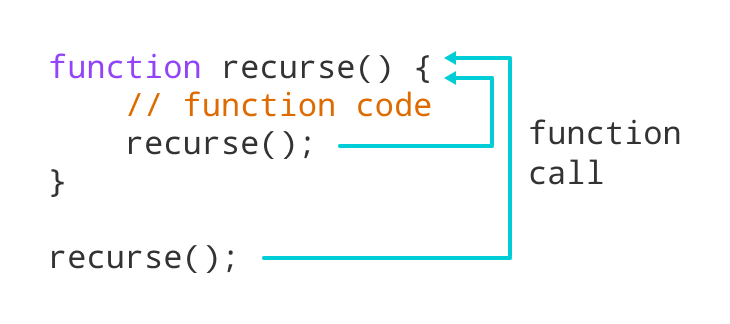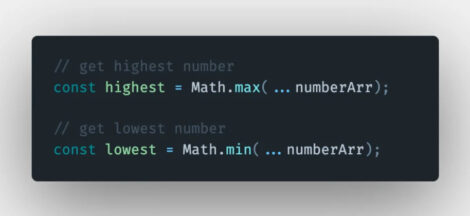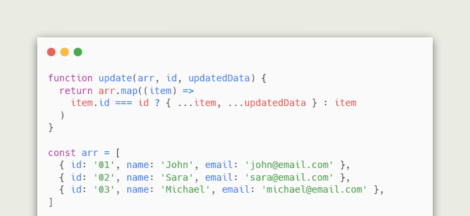A recursive function is a function that calls itself until it doesn’t. And this technique is called recursion.
The three key features of recursion
All recursive functions should have three key features:
A Termination Condition
Simply put: if(something bad happened){ STOP }; The Termination Condition is our recursion fail-safe. Think of it like your emergency brake. It’s put there in case of bad input to prevent the recursion from ever running. In our example, if (condition) return; is our termination condition.
A Base Case
Simply put: if(this happens) { Yay! We're done }; The Base Case is similar to our termination condition in that it also stops our recursion. But remember, the termination condition is a catch-all for bad data. Whereas the base case is the goal of our recursive function. Base cases are usually within an if statement .
The Recursion
Simply put: Our function calling itself. In the example, countDown(nextNumber); is where the recursion actually happens.
Suppose that you have a function called recurse(). The recurse() is a recursive function if it calls itself inside its body, like this:
function recurse() {
// ...
recurse();
// ...
}A recursive function always has a condition to stop calling itself, otherwise, it will call itself indefinitely. So a recursive function typically looks like the following:
function recurse() {
if(condition) {
// stop calling itself
//...
} else {
recurse();
}
}Generally, recursive functions are used to break down a big problem into smaller ones. You can find that they are heavily used in the data structures like binary trees and graphs and algorithms such as binary search and quicksort.
JavaScript recursive function examples
Let’s take some examples of using the recursive functions.
1) A simple JavaScript recursive function example
Suppose that you need to develop a function that counts down from a specified number to 1. For example, to count down from 10 to 1:
3
2
1The following shows the countDown() function:
<script>
function countDown(fromNumber) {
document.write(fromNumber + ' ');
}
countDown(3);
</script>
This countDown(3) shows only the number 3.
To count down from the number 3 to 1, you can:
- show the number 3.
- and call the
countDown(2)that shows the number 2. - and call the
countDown(1)that shows the number 1.
The following changes the countDown() to a recursive function:
<script>
function countDown(fromNumber) {
document.write(fromNumber + ' ');
countDown(fromNumber - 1);
}
countDown(3);
</script>This countDown(3) will run until the call stack size is exceeded, like this:
Uncaught RangeError: Maximum call stack size exceeded.… because it doesn’t have the condition to stop calling itself.
The count down will stop when the next number is zero, therefore, we add an if condition as follows:
<script>
function countDown(fromNumber) {
document.write(fromNumber + ' ');
let nextNumber = fromNumber - 1;
if (nextNumber > 0) {
countDown(nextNumber);
}
}
countDown(3);
</script>Output:
3
2
1The countDown() seems to work as expected.
However, as mentioned in the Function type tutorial, the name of the function is a reference to the actual function object.
If somewhere in the code, the function name is set to null, the recursive function will stop working.
For example, the following code will result in an error:
let newYearCountDown = countDown;
// somewhere in the code
countDown = null;
// the following function call will cause an error
newYearCountDown(10);Error:
Uncaught TypeError: countDown is not a functionHow the script works:
- First, assign the
countDownfunction name to the variablenewYearCountDown. - Second, set the
countDownfunction reference tonull. - Third, call the
newYearCountDownfunction.
The code causes an error because the body of the countDown() function references the countDown function name which was set to null at the time of calling the function.
To fix it, you can use a named function expression as follows:
<script>
let countDown = function f(fromNumber) {
document.write(fromNumber + ' ');
let nextNumber = fromNumber - 1;
if (nextNumber > 0) {
f(nextNumber);
}
}
let newYearCountDown = countDown;
countDown = null;
newYearCountDown(10);
</script>2) Calculate the sum of digits of a number example
Given a number e.g., 324, calculate the sum of digits 3 + 2 + 4 = 9.
To apply the recursive technique, you can use the following steps:
f(324) = 4 + f(32)
f(32) = 2 + f(3)
f(3) = 3 + 0 (stop here)So
f(324) = 4 + f(32)
f(324) = 4 + 2 + f(3)
f(324) = 4 + 2 + 3 The following illustrates the sumOfDigits() recursive function:
<script>
function sumOfDigits(num) {
if (num == 0) {
return 0;
}
return num % 10 + sumOfDigits(Math.floor(num / 10));
}
const sum = sumOfDigits(324);
document.write(sum);
</script>How it works:
- The
num%10returns the remainder of the number after divided by 10, e.g.,324 % 10 = 4 - The
Math.floor(num / 10)returns the whole part of thenum / 10e.g.,Math.floor(324 / 10) = 32 - The
if(num == 0)is a condition that stops calling the function.
Summary
- A recursive function is a function that calls itself until it doesn’t
- A recursive function always has a condition that stops the function from calling itself.





 Testing HttpClient Requests in Angular
Testing HttpClient Requests in Angular